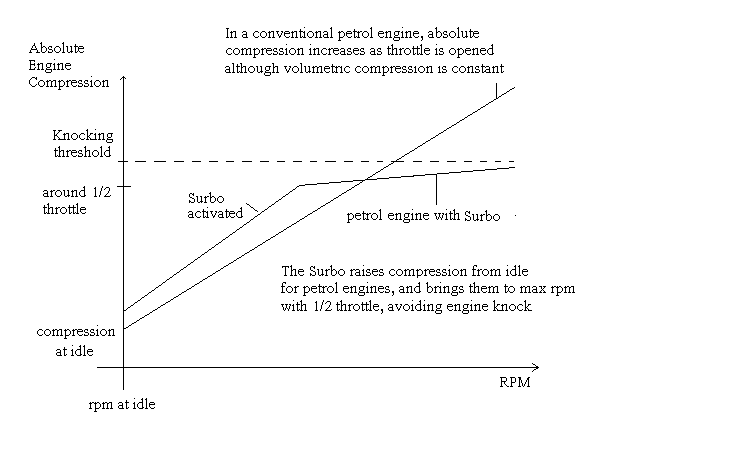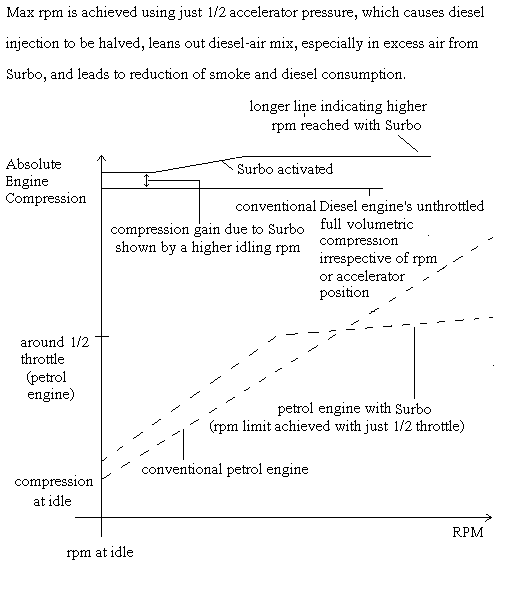

















1. By changing the flat-top pistons to high compression ones that curve upward to result in a higher compression ratio. However, since the air and fuel are both more highly compressed, there will be more heat. The fuel will start burning spontaneously (before the spark plug ignites) and this causes knocking (which is a flame front coming down at the piston trying to go upwards), and this reduces engine power. It is for this reason that only higher octanes are usable in modern engines, because lower octanes like 92 are more prone to knocking.
2. Turbocharging. This gives maximum power when the turbocharger is spooled up beyond 3000 rpm, but below that engine speed the turbo will slow the engine down as it is exhaust driven. This is called turbo lag. Furthermore, to be prepared for the very high effective net engine compression that results when the turbo comes on fully, the engine must have an inherently low compression ratio such as 8:1, which further takes away power before the turbo is up. This in all causes higher fuel consumption in turbocharged cars.
3. Supercharging. This gives an increased charge proportional to rpm, but loads the engine straightaway like an aircon pulley. At low rpm the boost effect is also noticeably absent.

This is done using a Surbo (air-suction-turbo, an engine back pressure activated vortex generator). The Surbo gives higher air pre-compression in the air intake, outside of the cylinder so it does not increase the fuel compression in the cylinder (like in 1.), and does not cause knocking. In fact, the owner of a '09 Chevrolet Captiva 2.4 reported that knocking noises were gone after the Surbo was fitted. The Surbo achieves the desired higher compression safely without causing excessive compression heat in the engine. By the time the Surbo-assisted engine hits the rpm red line, the accelerator is pressed just halfway, so the Surbo gives good engine power with safe, moderate compression. You can still remove the rev limiter though, and extend the rpm by flooring the accelerator, using all available compression. The Surbo is also the least costly and most fuel-efficient way to improve compression.
The Surbo can also be used in
1. Very high compression engines to lessen the fuel input and prevent knocking, or enable usage of lower octane fuel (this is because with a Surbo, less of the accelerator is pressed, so fuel put in is less).
2. Turbocharged engines, to cut the turbo lag. The Surbo's pre-compression from low rpm before the turbo is up increases the engine's inherent compression, and the increased air flow moves faster through the exhaust, thus spooling the turbo sooner (at a lower rpm) so cutting the lag and fuel consumption, and improves overall response. As the more efficient engine is now running ahead of the turbocharger, it will encounter lesser turbo pressure for the same engine speed. It is a fact that our test car, the Peugeot 508 1.6 turbo, red-lined with 1/2 throttle at just 0.6 bar, vs the 1.2 bar full-throttle red line of a similarly-powered car from another brand. The extra headroom might mean that higher revs can be allowed at the original pressure setting.
Surbo-fitted turbo vehicles include the Volvo S60 T6 (250 bhp) and XC90, Subaru Forestor, Daihatsu Charade Turbo 1.0 and GTti, Toyota Starlet 1.3 Turbo, and turbodiesels like the VW Caddy TDi, Opel Combo and Mercedes Vito 110 and automatic 112, and more. The Surbo might be added to modern high-compression petrol turbocharged engines with lower capacities, for while these have sufficient power most of the time as the car bodies are lightweight, when they are overloaded with many passengers the power may not be enough.
3. Supercharged engines (as in Mercedes Kompressor C180) to increase the low rpm power and enable them to cross more easily into the upper rpm range where the supercharger will take over, especially if it is automatic and normally limited by the gearbox to operate in the lower rpm range.
4. Diesel engines. When a Surbo is fitted in a diesel engine, the diesel engine becomes more powerful even from idle, showing improved engine compression (as diesel engines are compression-ignition). The revs go higher, and visible black smoke is reduced, indicating that less diesel is required to move an engine due to better air compression from the Surbo.

Our latest test vehicle, the 2019 Peugeot Expert 1.6 turbo-diesel fitted with Surbo, would red-line with half accelerator pressure with a boost meter reading of just 1.5 bar. Compare this with the average 2.5 bar faced by other comparable turbodiesels at a full throttle red-line. This gives the Surbo-equipped engine scope for further tuning (which usually means higher turbo pressures and heat) by third parties, or allows higher rpm at the same turbo pressure if the rpm limit is set higher. Left alone, this same Surbo-equipped engine would last longer as it can avoid excessive turbo pressure. Call us today to put the Surbo on your vehicle!
Watch the video above showing how an engine revs with Surbo. Or watch it with the How it works page.
Above: video of Volvo XC90 T8 with Surbo, sprinting to 130 kph.
Above: video of Volvo XC90 T8 with Surbo, sprinting to 211 kph.
Above: video of Volvo XC90 T8 with Surbo, sprinting to 224 kph.

More torque and BHP (dyno test)
Quick revving (1/2 throttle to RPM limit)
If you are using a handphone to read this, you can press the above CHAT link to either call us, or to save our number to your contacts, and then you can message us by clicking the WhatsApp icon below.